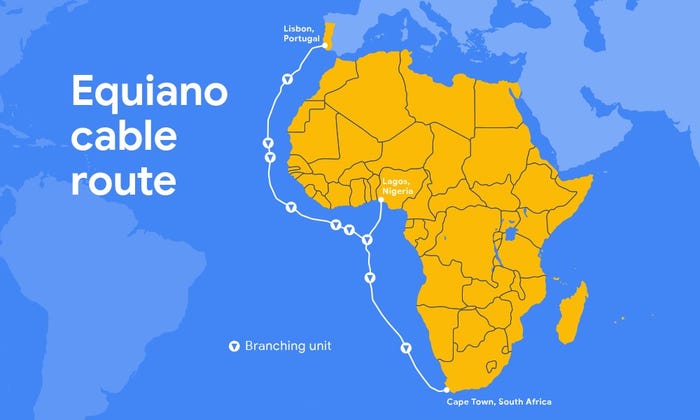Google’s New Switching Tech Makes Its Latest Subsea Cable Cheaper, SimplerGoogle’s New Switching Tech Makes Its Latest Subsea Cable Cheaper, Simpler
The Equiano cable along Africa’s west coast will be the first to use fiber-level switching. Here’s what that means.

Equiano, Google’s new private subsea cable Alcatel-Lucent Submarine Networks is building along Africa’s west coast -- it will stretch from Cape Town to Lisbon -- will have about 20 times the capacity of the last cable built to serve the region, according to the Alphabet subsidiary. Yet, thanks to a new switching technology the two companies developed together, it will be simpler to deploy and cost less than comparable systems built to date.
The technology is fiber-level switching. Made possible by the higher amount of fibers that can now be in a single cable (also a recent innovation Google had a hand in), it eliminates a lot of expensive equipment that’s traditionally deployed alongside cables on the seabed.
Traditionally, consortia of big telcos and governments have funded and owned submarine cables, leasing capacity on the systems to those who need it. In recent years, however, in a trend started by Google, a handful of tech giants, which now also includes Microsoft, Facebook, and Amazon, have been investing in new cable projects directly. In some cases, they’ve done it by joining the consortia; in others, they’ve paid for entire cable systems of their own, doing it both to expand intercontinental bandwidth and to improve resiliency by adding redundant network routes to circumvent cable faults.
Participating in the projects directly, the tech giants’ infrastructure teams have done what they do best: innovate to boost capacity, improve efficiency, and lower cost.
One Tech Leads to Another
By introducing fiber-level switching on Equiano, Google is building on an innovation introduced in another subsea-cable build, announced last year. When it lights up in late 2020, that cable, called Dunant, will move data between Virginia Beach, Virginia, and Saint-Hilaire-de-Riez, France.
According to Google, Dunant will be the first subsea cable to use space-division multiplexing, or SDM. The technology allows the maximum number of fiber pairs (one fiber for each direction data travels) in a cable to go from six to more than 12, Vijay Vusirikala, director of network architecture and optical engineering for Google Cloud, explained in an email to DCK.
In the low-fiber-count, pre-SDM world, switching a signal’s path on a cable required splitting the spectrum into individual wavelengths and confining the signal to a particular wavelength. It’s a neat concept, but the equipment for wavelength-level switching is expensive and complicates a cable’s deployment.
The tech Google and Alcatel-Lucent are introducing in Equiano does away with wavelength-level switching, replacing it with fiber-level switching. Since SDM allows for way more fiber pairs, it’s easier to just switch mechanically from pair to pair than from wavelength to wavelength.
“Fiber switching technology was developed in collaboration between Google and our subsea cable provider,” Vusirikala said.
It “results in a more compact, cost-effective, and power-effective switching solution.”
Trunks and Branches
The reason you want many paths to switch between on a subsea cable system is these systems’ “trunk-and-branch” architecture. Branches connect onshore landing stations to the cable’s trunk on the ocean floor.
In addition to Cape Town and Lisbon, the Equiano cable will also initially land in Lagos, Nigeria (where Google’s platform has a point of presence), about halfway between the other two landing stations. Each point where a branch connects to the trunk has a “branching unit,” and Equiano will have nine such units along its length so that more branches can be added in the future.

equiano google submarine cable route
In the traditional model, a piece of sophisticated, high-reliability optical equipment for spectrum splitting – “a wavelength selective switch” – is placed on the ocean floor, several kilometers away from each branching unit, Vusirikala explained. It “splits the spectrum into individual wavelengths, switches portions of the spectrum to the branch, and sends the remaining portions of the spectrum to the trunk.”
This equipment needs its own enclosures, but it also introduces “optical loss.” The loss is compensated for by optical amplifiers which further increase cost of the system.
Fiber-level switching makes all this extra gear unnecessary. The Alcatel-Lucent-developed opto-mechanical equipment that will switch fibers from position to position on the Equiano cable will be placed right at the branching units, lowering the system’s overall cost, according to Vusirikala.
Google Cloud Data Centers Coming to Africa?
Equiano will be Google’s third wholly-owned submarine cable out of 13 systems it’s funded so far. Asked whether its massive investment in bandwidth between Europe and Africa was a precursor to building the first Google Cloud data centers in Africa, a Google spokesperson declined to comment.
But that’s a likely scenario. The company has been spending heavily on infrastructure around the world as it competes for cloud market share with Amazon Web Services and Microsoft Azure, among others. Microsoft beat its competitors to launching the first Azure data centers on the continent (in South Africa) earlier this year, and Amazon isn’t far behind, expecting to a launch an AWS availability region in Cape Town in 2020.
After having spent $47 billion on infrastructure over the last three years, Google now has cloud availability regions on every continent except Africa, so it wouldn’t be a stretch to imagine that the company will soon fill that gap.
Read more about:
Google AlphabetAbout the Author
You May Also Like






